Anyone who has watched a few baseball games will see that not every baseball field is the same size. However, suppose you have read the rulebook. In that case, you will know that the Major and Minor Leagues ask that all fields be designed following specific rules. But not all of them are followed to the letter.
So why are baseball fields have different sizes? To give you the full answer, we will need to look at all 30 MLB baseball fields and learn about their sizes. The difference in size is sometimes related to architecture, history, and a few other reasons. We will be looking at all of the biggest to the smallest fields.
Before we look at the fields individually, I will inform you about the standards that MLB has set for all fields. Knowing about the standard beforehand will help us understand which areas are different for each MLB field. Once we are done, we will look at each MLB field.
Table of Contents
Major League Baseball stadiums: Standard size
This won’t come as a surprise, but there is a standard set of measurements that all baseball fields need to follow. But baseball fields have different sizes because not all of those are followed to the letter. In fact, other than the infield, the rest can be designed quite differently, as you will see. Because of this, some might say is baseball a sport if the fields aren’t the same.
For better understanding, we will divide the field into multiple parts and explain each separately.
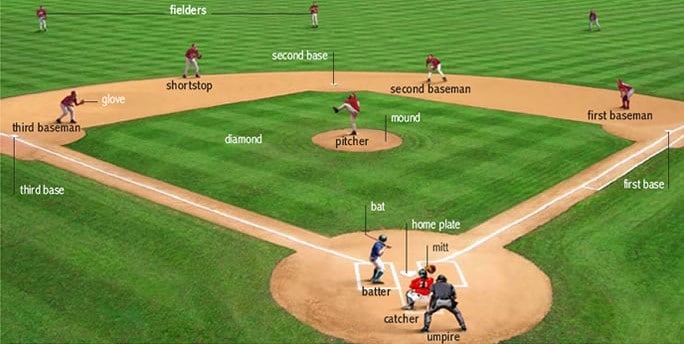
Infield & outfield
Generally speaking, a baseball infield takes a square shape, with each side measuring exactly 90 feet. The areas called outfield are set between the foul lines, which we talk about later. The field design ensures that the bases are level with the home plate.
Fences & Foul lines
After 1958 all baseball fields had to follow the basic guidelines for fences but the ones built before 58 didn’t have any. But some baseball fields received some leeway regarding this rule once they consulted MLB.

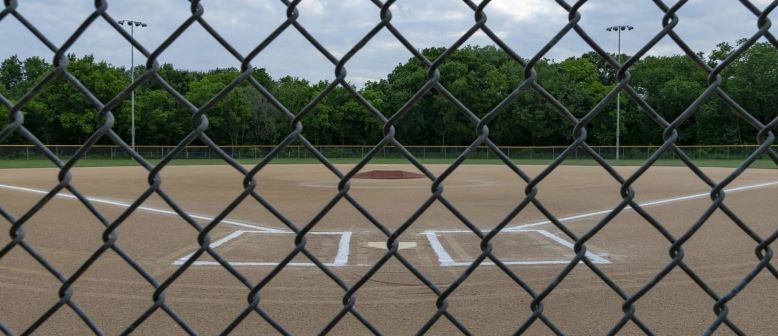
Regardless, the distance between the home plate and outfield walls, fences, or foul lines must be 325 feet at a minimum. Also, the home plate must be 400 feet from the center field fence.
Pitcher’s mound
To have specifications for a place where the pitcher is to stand might seem ridiculous. Still, baseball is a game filled with rules and regulations. A standard MLB pitcher’s plate uses a slab of white rubber. This slab measures 6 inches by 24 inches. Additionally, the pitcher’s plate is placed 60 feet away from the home plate.
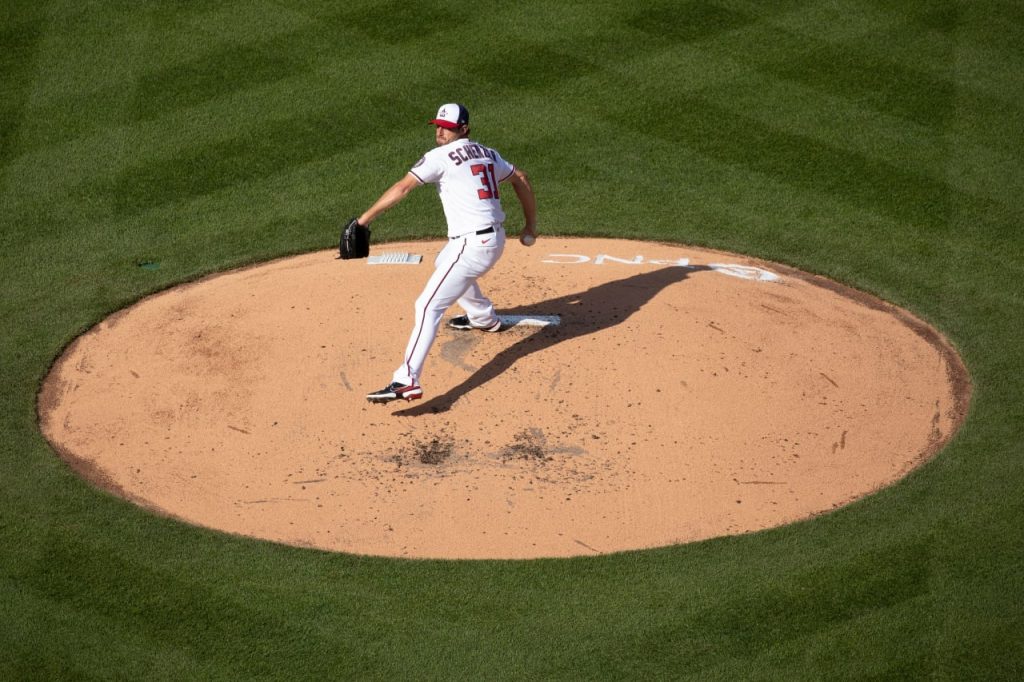
Furthermore, the plate is 18 inches off the center of the mound, and its surroundings have a level of 5 feet and 34 inches. The pitcher’s mount is inside a circle with a diameter of 18 feet. Finally, every MLB standard mount must also have a slope of 6 inches from the pitcher’s plate.
Home plate
Similar to the pitcher’s plate, the home plates use a white rubber that needs to meet a standard requirement. These requirements are that the plate needs to be square with a length of 17 inches. But 2 of its corners are to be removed; thus, the sides are 8.5 inches.
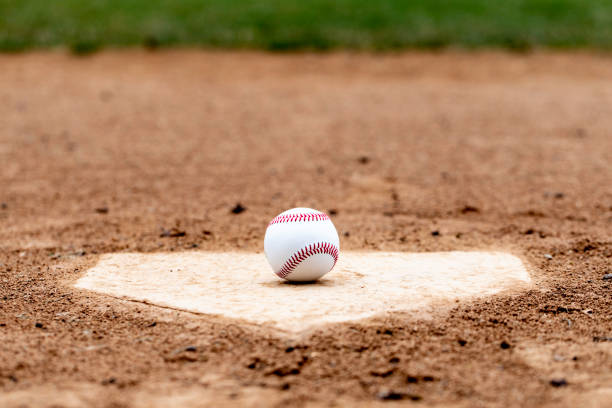
As the home plate is being set, you must ensure that the back tip is 127 feet away from the second base. The longer side of the home plate needs to face the pitcher, while the shorter sides are parallel to the first and second baselines.
Major League stadiums:
I have talked about the standard rules regarding the baseball fields and the measurements they need to follow. However, we will be talking about how 30 baseball fields have different sizes.
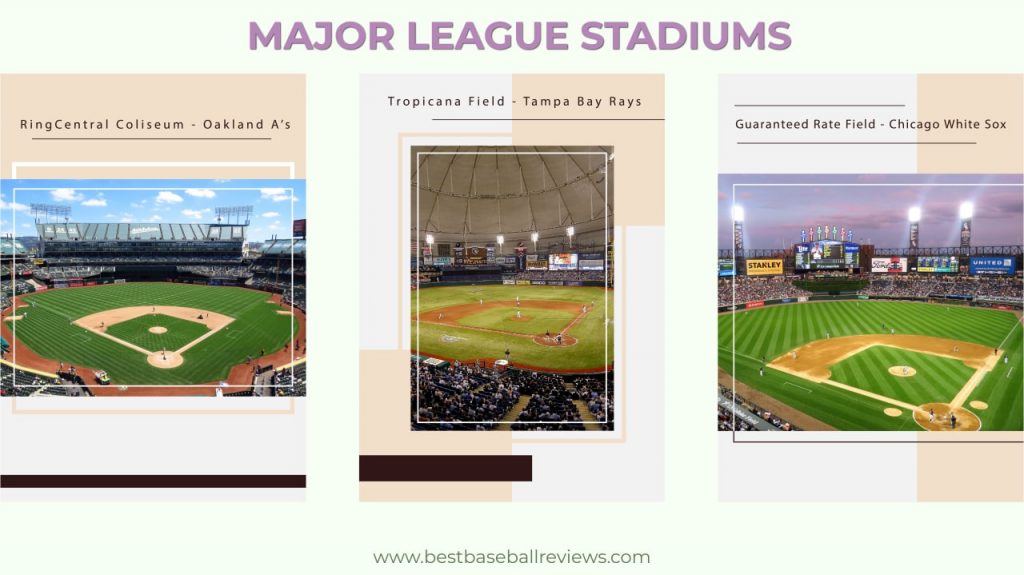
RingCentral Coliseum – Oakland A’s
Previously known as the Oakland Coliseum, this baseball field is one of the lesser liked fields currently in use. The stadium is rarely more than half full. It was built in 1966 as a football stadium, so its layout is rather peculiar. However, its outfield does catch your attention quite well. Additionally, this stadium is multipurpose with retractable seating that can raise the left and right center by 15 feet.
Moreover, the right and left-center fields are 388 feet from the home plate, while the centerfield is 400 feet from the home plate. Due to the home to fence distance, the RingCentral Coliseum is one of the best fields to hit triples.
Tropicana Field – Tampa Bay Rays
Many fans think that the Tropicana field has many issues. Still, many of them do agree that the outfield is pretty great. The corners of the Trop are shallow, while the left and right walls are kept straight and not curved. The left outfield fence is 315 feet from the home plate, and the right fence is 322 feet from the home plate.
The biggest issue that all the players agree on is the catwalks. Of course, it isn’t a part of the outfield. But any true fan will tell you that there shouldn’t be any barrier that can interfere with the flight of a hit ball. Finally, the center of the field is 404 feet from the home plate.
Guaranteed Rate Field – Chicago White Sox
Originally called the “New Comiskey” back in 1991, its design was similar to those that came before it. The foul poles were 347 feet away from home plate. But in 2001, it was renovated, and the left- and right fences were brought closer. The left fence was now at 330 feet, and the right was 335 feet from the home plate.
Also, the dead center of the field was exactly 400 feet from the home plate. In the beginning, the Guaranteed Rate field was a pitcher’s park. Still, after the renovation, it turned into a batter’s park.

Rogers Centre – Toronto Blue Jays
Like the Oakland A’s field, the Rogers Centre is another example of multipurpose stadiums. The left and right fields are 328 feet from the home plate, while the dead center is 400 feet. This field is one of two that have symmetrical outfield dimensions and uniform wall height. They were the first to break the record that will never be broken with more than four million to pass through their turnstile but it was later broken.
During the 2021 season, the Jays started to play in the spring training facility called the TD Ballpark. The overall design is a mirror image of the Target Field, with some renovation that took place before the 2020 season. The left-field fence was lowered and contained a deep power alley in the left-center and a taller fence on the right side.
Angel Stadium – Los Angeles Angels
The Angel stadium was optimized for the Rams but was returned to its old design when they left for St. Louis. The left and right fences are 347 feet and 350 feet from the home plate, and the center to the home plate is 396 feet. On average, you can hit homers here quite easily, but triples are hard.
Miller Park – Milwaukee Brewers
The fence distances are nearly identical, left 344 feet and right 345 feet from home plate, but they meet at odd angles. This design brings some unpredictability to balls hit when they bounce off of the wall. The distance between the home plate and center field is 400 feet.
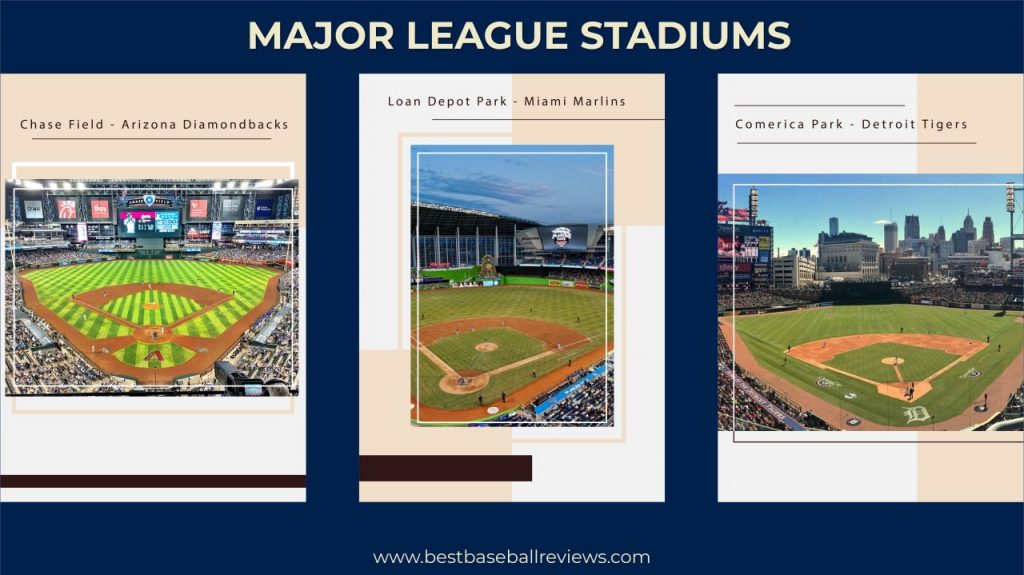
Chase Field – Arizona Diamondbacks
If you are looking for tall walls near the foul line, look no further than the Chase Field for the Arizona Diamondbacks. Their foul line wall stands at 25 feet tall! The left fence distance is 330 feet, and the right fence is 334 feet. The centerfield is 407 feet from the home plate.
Due to the centerfield being so far away, the Chase Field sees the most amount of triples among all MLB fields.
LoanDepot Park – Miami Marlins
The distance between the home plate and the left and right fences is 344 and 335 feet. The dead center is 400 feet from home plate. However, the most identifiable feature of the Marlins park is its home run sculpture. This statue was removed before the 2019 season, and before the 2020 season, the centerfield wall was brought in.
Comerica Park – Detroit Tigers
The Comerica Park was built to replace the Tigers previous field that stood from 1912 to 1999. Originally there was a flagpole just left of dead-center, but that was removed in 2003. Furthermore, the left-center power alley had a distance of 395 feet, which was also changed in 2003 when the fences were brought in.
Currently, the dead center is 420 feet away from home plate; can you even imagine that? And the left and right fences are 345 and 330 feet from home plate, respectively. Due to the overall size of the stadium, batters can hit a decent number of homers but deep enough for centerfielders to show off their stuff.

Great American Ball Park – Cincinnati Reds
Great American Ball Park or GABP is one of the top five fields in turns of home runs hit. And its outfield is smaller than the Yankee Stadium, but it has a high left wall. The dead center is 404 feet from the home plate, while the left and right fences are 328 feet and 325 feet from the home plate.
Progressive Field – Cleveland Guardians
Many know them as the Cleaveland Indians, but in 2021 they changed their name to Guardians. This field is one of the worst places for a power hitter due to its 19 foot wall in the left field. The fences are 325 feet away from home plate in both directions. And the center field is 400 feet away.
Globe Life Field – Texas Rangers
The left-field foul lines and right-field foul lines are 329 and 326 feet away, while the center is 407 feet away. A fun part of this field is there are a lot of easter eggs hidden away and waiting to be discovered by die hard fans.
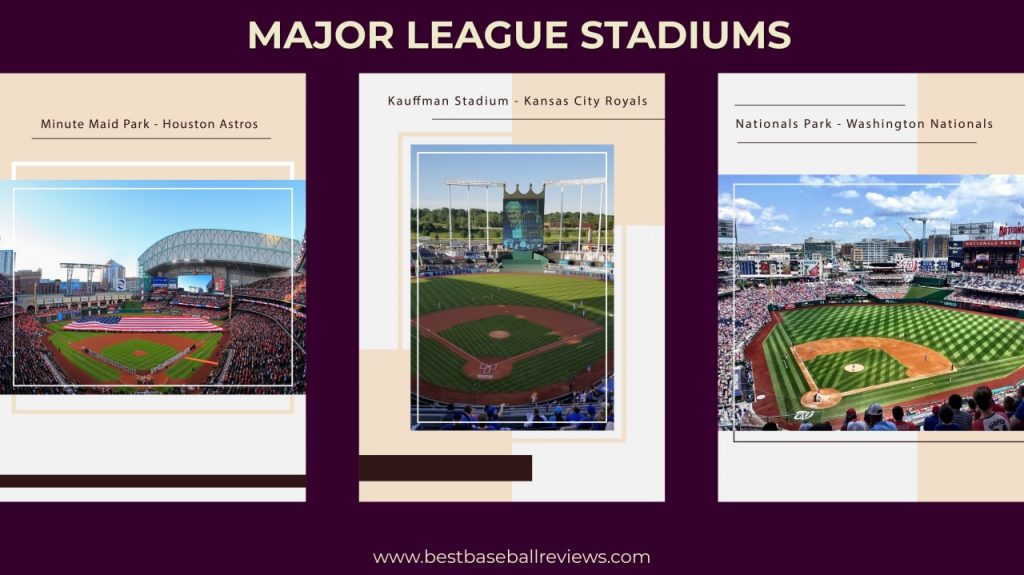
Minute Maid Park – Houston Astros
The left fence is quite short at 315 feet, the right fence is 325 feet, and the center is 409 feet away. The “Crawford Boxes” is one of its wacky features that are still around, while the “Tal’s Hill” slope was removed before the 2017 season.
Kauffman Stadium – Kansas City Royals
Sometimes called The K was built during the ’60s and ’70s and has kept its “cookie-cutter” symmetry. The fences are 330 feet from the home plate, and the center is 410 feet away.
Nationals Park – Washington Nationals
The distances for the left and right fences are 337 and 335 feet, while the center distance is 402 feet. There are a few nice touches to the Nats Park.
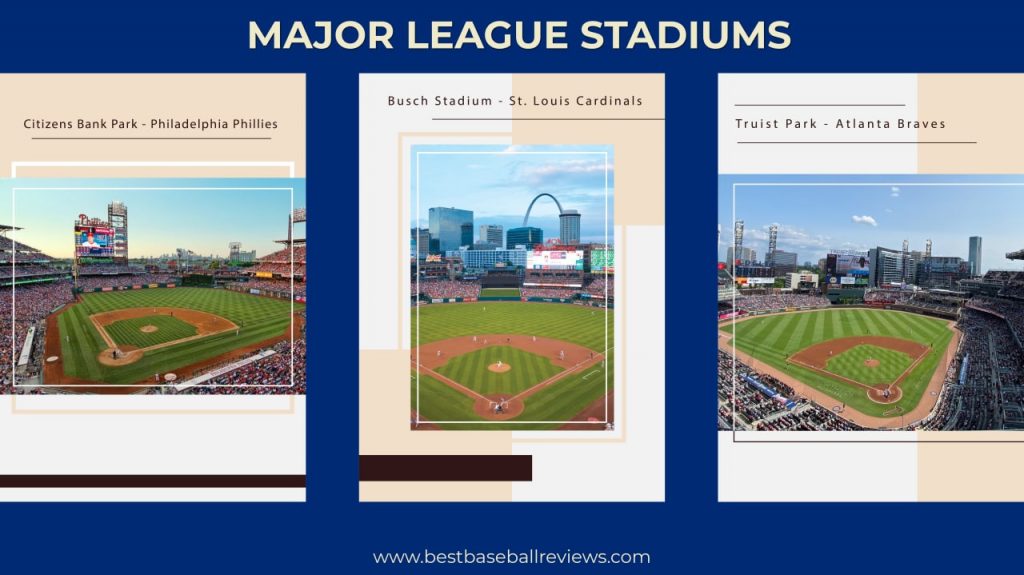
Citizens Bank Park – Philadelphia Phillies
A key difference of the Philly park is that its centerfield wall is quite short. This allows outfielders to jump the wall and catch would-be homers. The fence distances are 329 feet and 330 feet for the left and right sides, and the center distance is 401 feet.
Busch Stadium – St. Louis Cardinals
Currently, the Cardinals play at the Busch Stadium II, slightly different from its previous ballpark. The left foul line is 336 feet away, the right line is 335 feet long, and the center is 400 feet away.
Truist Park – Atlanta Braves
The left foul line is 335 feet away, the right line is 325 feet long, and the center is 400 feet away. This park doesn’t favor hitting from the left or right side by players.

Camden Yards – Baltimore Oriole Park
This park contains a scoreboard situated at the rightfield wall and is placed 21 feet in the air. The left foul line is 333 feet away, the right line is 318 feet long, and the center is 400 feet away.
Citi Field – New York Mets
If you wanted to know what happens when you do too much with modern stadiums then just look at the Mets Citi Field. Within six years the design of the field was changed twice to turn it from its original look into a standard ballfield. The current distance for the left and right are 335 and 330 feet with the center being 408 feet from home plate.
T-Mobile Park – Seattle Mariners
The Mariners Park used to be a rather pitcher-friendly field where righthand batters could hit a lot of doubles and triples but it all changed in 2013. The current design is still pitcher-friendly, but batters are hitting lot more homers. The left fence is 331 feet in length and the right fence is 326 feet with the center being 401 feet away.
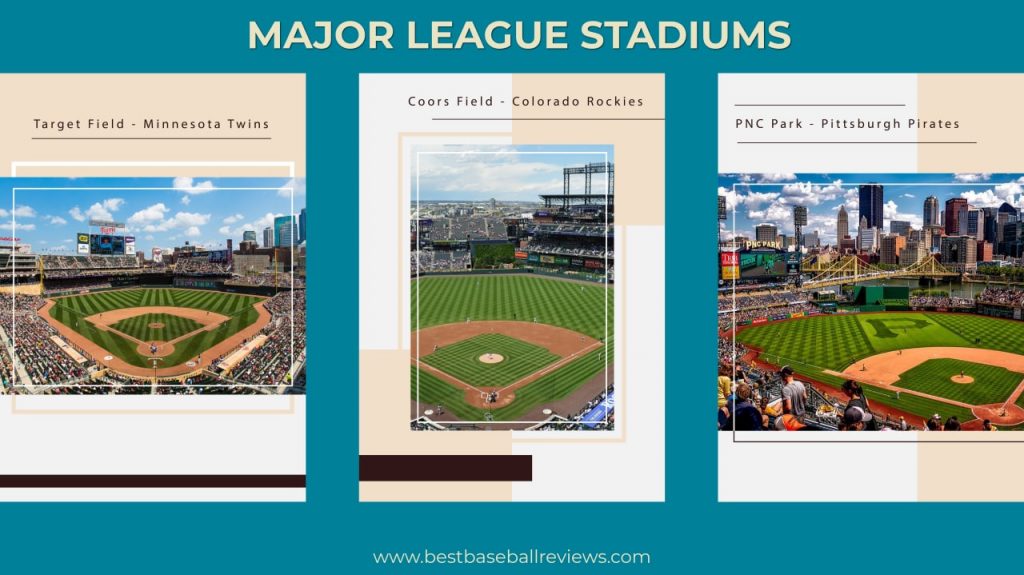
Target Field – Minnesota Twins
Their 23 feet tall rightfield wall is the fifth tallest among MLB parks, and before it was built, it was quite hard for lefties to hit homers. Back in 2019, the Twins hit more home runs than any other team in MLB. The left and right fences of the Target Field are 339 feet and 328 feet from the home base and the dead center is 403 feet away.
Coors Field – Colorado Rockies
One part of Coors Field design that is unique and frustrating is that the walls are deep, lowering the home run count. At the same time, this design increases the number of triples. The dead center is 415 feet away while the left and right fences are 347 and 350 feet away.
PNC Park – Pittsburgh Pirates
The PNC Parks left and right fences are 325 and 320 feet away while the dead center is 399 feet away from the home base. The Pirates stadium has a leftfield corner 11 feet further than the center of the park. Also, the rightfield wall is 21 feet tall in honor of Roberto Clemente.

Oracle Park – San Francisco Giants
Firstly, the fences are 339 feet away on the left side and 309 feet on the right side while the center is 391 feet away. With the right side being so close you would think hitting homers would be child play, but the 25 feet wall, the second tallest, stops all of that.
Petco Park – San Diego Padres
This old stadium has a 100+ year old building diving the foul and fair line on the leftfield side. The park was originally created around the Western Metal Supply Company building. This park’s left and right foul lines are 334 feet and 322 feet long. The center of the field is 396 feet away from the home plate.
Dodger Stadium – Los Angeles Dodgers
The Dodger Stadium looks a lot like the Kauffman field. However, this field has some low walls which provide some amazing home run robberies. The left and right fences of the Dodgers field are 330 feet long and the center is 400 feet away.

Wrigley Field – Chicago Cubs
Back in the hay day, the Wrigley outfield was a mess and it wasn’t until 1938 that the field dimension changed frequently. With the left fence being 355 feet and the right fence being 353 feet away the foul line is the longest of all fields. And the center of the field is 400 feet from the home plate.
Yankee Stadium – New York Yankees
The current Yankee Stadium is the same as there before but doesn’t play like it used to. The left and right foul lines are 318 and 314 feet in length. The center of the field is 408 feet in length.
Fenway Park – Boston Red Sox
Before we end this list we need to talk about the Boston Red Sox Fenway Park. It is called the Green Monster. The left line is 310 feet, the right line is 302 feet, and the center is 390 feet. At the rightfield stands the “Pesky Pole” which is 302 feet from the plate that turns flyballs into homers.
Frequently Asked Questions(FAQs)
The smallest baseball field the smallest size is the Tropicana Stadium in St. Petersburg, Florida home of the Tampa Bay Rays. It has a seating size of 31,042 people. Additionally, the Progressive Field and Marlins Park can also be on this list of small baseball fields with their different sizes.
There isn’t a straight answer to this question. Each foul poles in each of the MLB fields have a different height. They can be as short as 15’ to as tall as 80’. The height required is determined by several facts like the overall size of the field, its fences, and whether you will be playing baseball or softball.
The Coors field has many factors that works together perfectly to make it the best field to hit homers. These factors include altitude, wind, and dry air that blows through this field. Back in 2012 on average 2.8 home runs were hit in this field.
The MLB rulebook states, “It is desirable that the line from home base through the pitchers plate to second base shall run East Northeast.” While there is no must, it’s just implied.
Conclusion
The baseball field’s infield needs to be in the shape of a square with 90 feet in length and the pitcher’s plate needs to be exactly 60 feet from the home plate. The foul lines are supposed to be 325 feet long, while the center of the field should be 400 feet. However, this is one rule that the stadiums can change after consulting MLB directly. And this is why baseball fields have different sizes.



